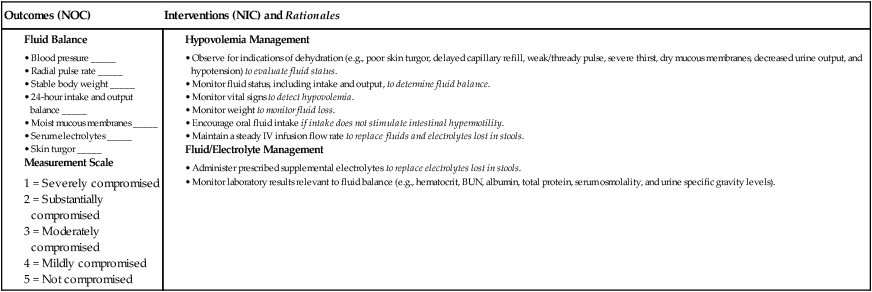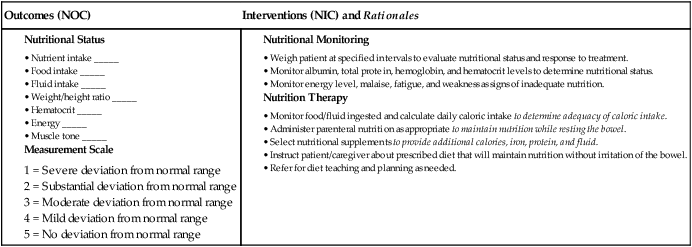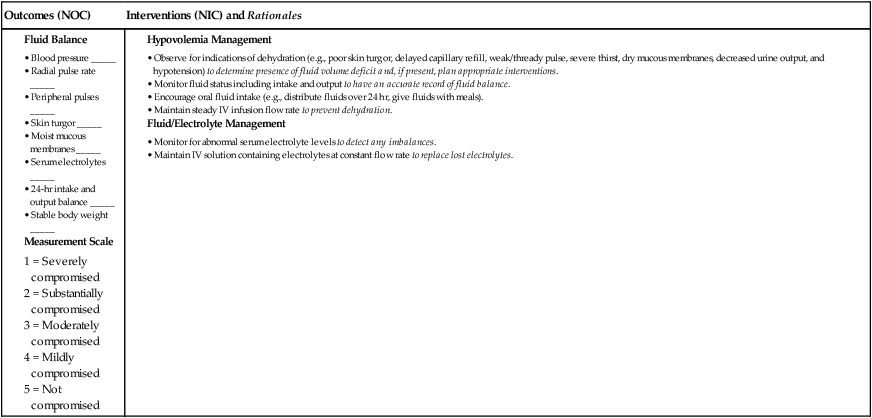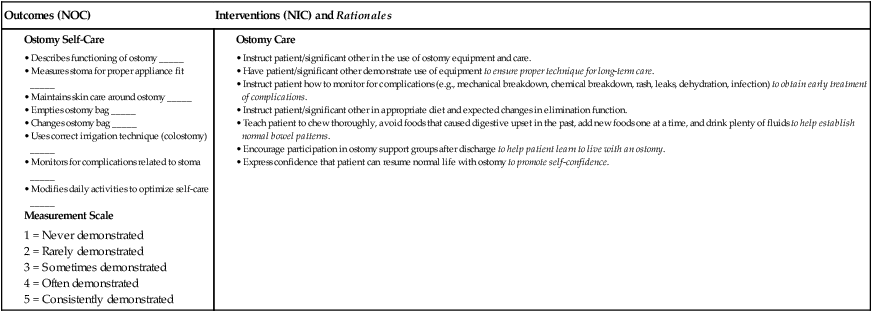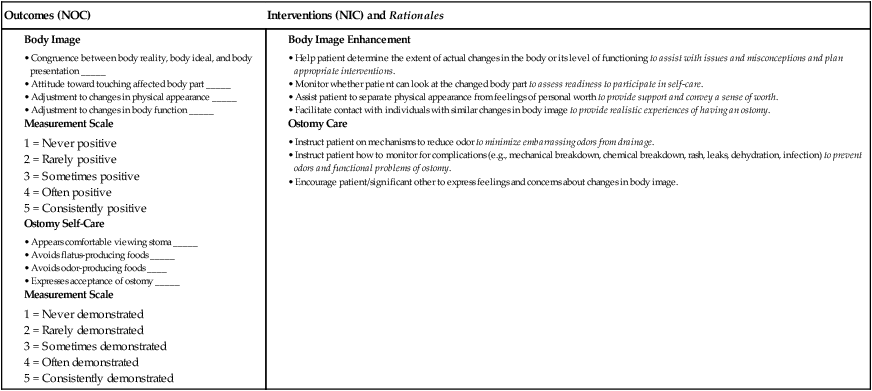1. Explain the common etiologies, collaborative care, and nursing management of diarrhea, fecal incontinence, and constipation. 2. Describe common causes of acute abdominal pain and nursing management of the patient after an exploratory laparotomy. 3. Describe the collaborative care and nursing management of acute appendicitis, peritonitis, and gastroenteritis. 4. Compare and contrast the inflammatory bowel diseases of ulcerative colitis and Crohn’s disease, including pathophysiology, clinical manifestations, complications, collaborative care, and nursing management. 5. Differentiate among mechanical and nonmechanical bowel obstructions, including causes, collaborative care, and nursing management. 6. Describe the clinical manifestations and collaborative management of colorectal cancer. 7. Explain the anatomic and physiologic changes and nursing management of the patient with an ileostomy and a colostomy. 8. Differentiate between diverticulosis and diverticulitis, including clinical manifestations, collaborative care, and nursing management. 9. Compare and contrast the types of hernias, including etiology and surgical and nursing management. 10. Describe the types of malabsorption syndromes and collaborative care of celiac disease, lactase deficiency, and short bowel syndrome. 11. Describe the types, clinical manifestations, collaborative care, and nursing management of anorectal conditions. eTABLE 43-1 ACUTE INFECTIOUS DIARRHEA: ETIOLOGY, SOURCES, AND TREATMENT eTABLE 43-2
Nursing Management
Lower Gastrointestinal Problems
Type of Organism
Symptoms
Source of Infection/Susceptibility
Medication Treatment
Viral
Rotavirus
Fever, vomiting, and profuse watery diarrhea
Lasts 3 to 8 days
Highly contagious
Most U.S. children get it by age 2 yr
Transmitted mainly by fecal-oral route
None, but vaccines RotaTeq and Rotarix are available for infants
Norovirus (also called Norwalk-like virus)
Nausea, vomiting, diarrhea, stomach cramping. Rapid onset
Lasts 1-2 days
Very contagious
Virus is present in stool and emesis
None
Bacterial
Enterotoxigenic Escherichia coli
Watery or bloody diarrhea, abdominal cramps
Nausea, vomiting, and fever may be present
Mean duration >60 hr
Most common cause of traveler’s diarrhea
Transmitted in water or food contaminated with infected feces
Antibiotics, but antibiotic resistance is common
Enterohemorrhagic E. coli (e.g., E. coli O157:H7)
Severe abdominal cramping, bloody diarrhea, and vomiting
Low-grade fever
Usually lasts 5-7 days
Can cause serious illness in anyone, but the young and elderly are most susceptible
May progress to life-threatening renal failure
Transmitted in water or food contaminated with infected feces, especially undercooked ground beef
None
See Table 42-24
Shigella
Diarrhea (sometimes bloody), fever, and stomach cramps
Usually lasts 5-7 days
Postinfection arthritis may occur
Transmitted via fecal-oral route from infected person to another, or in food or water contaminated with infected feces
Can also contaminate recreational water
Usually none, but certain antibiotics (e.g., ampicillin, trimethoprim-sulfamethoxazole [Bactrim]) may shorten the length of illness
Salmonella
Diarrhea, fever, and abdominal cramps
Lasts 4-7 days
Reservoir is poultry, reptiles, and other animals
Turtles, lizards, snakes, chicks, and young birds are especially likely to harbor the organism
Can be transmitted by handling the animals
Found in undercooked poultry, meat, and foods prepared with raw eggs
Usually none
Antibiotics are given if it spreads from intestine into bloodstream
Staphylococcus
Nausea, vomiting, abdominal cramps, and diarrhea
Usually mild
May cause illness in as little as 30 min
Lasts 1-3 days
25%-50% of people are carriers in their mucous membranes, skin, or hair
Most commonly transmitted in food contaminated by food workers who are carriers or through contaminated milk and cheese
Not affected by antibiotics
Campylobacter jejuni
Diarrhea, abdominal cramps, and fever. Sometimes nausea and vomiting
Lasts about 7 days
Undercooked poultry and unpasteurized milk
Most frequent in summer months
Erythromycin or fluoroquinolone are given in severe cases and to shorten duration of symptoms
Clostridium perfringens
Diarrhea, abdominal cramps, nausea, and vomiting
Occurs 6-24 hr after eating contaminated food and lasts approximately 24 hr
Associated with meats, gravies, and stews; commonly associated with dried or pre-cooked foods
Can cause serious illness in anyone, but the young and older adults are most susceptible.
None
Clostridium difficile
Watery diarrhea, fever, anorexia, nausea, abdominal pain
Prolonged use of antibiotics followed by exposure to feces-contaminated surfaces
Spores on hands and environmental surfaces are extremely difficult to kill
Vancomycin (oral); metronidazole (Flagyl; oral or IV); fidaxomicin (Dificid) for recurrent infection
Parasitic
Giardia lamblia
Abdominal cramps, nausea, diarrhea
May interfere with nutrient absorption
Highly contagious
Transmitted via fecal-oral route and is also found in fresh lakes and rivers
Most common intestinal protozoa worldwide
Has been transmitted in swimming pools, water parks, and hot tubs
Metronidazole
Entamoeba histolytica
Diarrhea, abdominal cramping
Only 10%-20% are ill, and symptoms are usually mild
Fecally contaminated food, water, or hands
Most common in developing countries
In the United States, high-risk groups include travelers, recent immigrants, and homosexual men
Antibiotics
Cryptosporidium
Watery diarrhea
Lasts about 2 wk
May also have abdominal cramps, nausea, vomiting, fever, dehydration, weight loss
Sometimes no symptoms
Long lasting and may be fatal in those who are immunocompromised (e.g., those with AIDS)
Lives in human intestines and is transmitted in stool of infected human or animal
Outer shell allows it to live for long periods outside of body and makes it resistant to chlorine
Common cause of waterborne disease (swimming pools, lakes, drinking water, food contaminated with feces)
Most with healthy immune systems recover without treatment
Nitazoxanide (Alinia) for people with healthy immune systems
Anti-retroviral therapy to improve immune function for those with AIDS

Colonic Disorders
Drug-Induced Causes
Systemic Disorders
Metabolic/Endocrine
Collagen Vascular Disease
Neurologic Disorders
![]()
Stay updated, free articles. Join our Telegram channel

Full access? Get Clinical Tree

 Get Clinical Tree app for offline access
Get Clinical Tree app for offline access

Nursing Management: Lower Gastrointestinal Problems
Get Clinical Tree app for offline access

